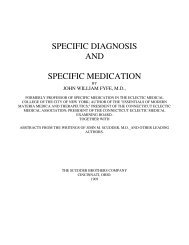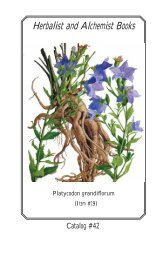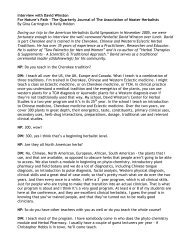MEDlCINAL PLANTS OF JAMAICA. PARTS 1 & 11.
MEDlCINAL PLANTS OF JAMAICA. PARTS 1 & 11.
MEDlCINAL PLANTS OF JAMAICA. PARTS 1 & 11.
Create successful ePaper yourself
Turn your PDF publications into a flip-book with our unique Google optimized e-Paper software.
The Mayas found the plant useful in treating asthma and sore tongue. The clarified fruit juice has been<br />
used for jaundice, gonorrhoea and diarrhoea.<br />
The leaves contain about 6% fat. 0.365% volatile oil containing eugenol. 8 to 15% tannin, 3.15% resin<br />
and some malic acid. The bark has 12 to 30% tannin and the root is also rich in this substance. (9, 13, 15, 16,<br />
27, 37, 38, 39, 56, 60, 61).<br />
NYCTAGINACEAE<br />
A small family of herbaceous and woody plants found mainly in America. Chemically they are little<br />
known.<br />
BOERHAVIA SCANDENS L. Rat Ears; Easy.to-Bruck.<br />
This plant is used to make tea for colds and is also considered to be an excellent treatment for marasmus<br />
("mirasmy") in children. In Africa and India various species of Boerhavia are considered useful as emetics,<br />
cathartics, diuretics, febrifuges, vermifuges, expectorants; astringents used in the treatment of dysentery,<br />
gonorrhoea and wounds; and as valuable in the treatment of asthma and dropsy. Boerhavia spp. are said to<br />
contain the alkaloid punarnavine. (7, 10, 14, 27, 39, 57, 61).<br />
MIRABILIS JALAPA L. Four o'clock: Marvel of Peru; False Jalap.<br />
This species probably finds little use in Jamaican home remedies but is used in baths for fever and colds.<br />
The root is said to have purgative properties: it contains carbohydrate and trigonellin. It was employed in earlier<br />
times in Jamaica as a laxative and is said to be so used in Cuba. In Antigua and India the leaves are said to be<br />
used as an application to ulcers and sores. The juice of the flowers is used in Cuba to treat freckles and<br />
herpes while the root is thought anthelmintic and useful in cases of dysentery and melancholia. (1, 5, 7, 15, 19,<br />
26, 27, 37, 47, 61).<br />
OXALIDACEAE<br />
A mostly herbaceous family of about three hundred and forty species, found mainly in the warmer<br />
regions of the world. Oxalic acid is commonly found in the plants both as calcium oxalate crystals and also in<br />
the form of dissolved potassium oxalate.<br />
OXALIS CORNICULATA L. Sour Grass; (N) Edge-Teeth; (Yellow or Wood) Sorrel.<br />
Oxalis spp. contain oxalic acid: they are commonly regarded as cooling. febrifuge. antiscorbutic and<br />
stomachic. O. corniculata is used in Jamaica to make tea which is regarded as antidiuretic (though Lunan<br />
reported it diuretic) and of value for the treatment of a "bad back". The species also finds use in Africa. Cuba.<br />
India. It has been much used in dysentery cases. to remove films from the cornea and. it is said. as an antidote to<br />
Datura poisoning. (5, 10, 14, 15, 26, 28, 39, 47, 48, 57, 61).<br />
PALMAE<br />
COCOS NUCIFERA L. Coconut Palm.<br />
Coconut milk is often used in tea prepared from various "bush tea" plants. We find it so used with<br />
Rytidophyllum (Search-my-Heart). Bidens reptans (Marigold). Eupatorium odoratum {]ack-in-the-Bush}. The<br />
very small nuts which often fall from the treee are occasionally included in the popular Sarsaparilla tonics or the<br />
root may be used instead. Coconut leaf is sometimes used with bryal wys (Smilax sp.) and sweet cup (Passinora<br />
-malitormis) to prepare a tonic. The root is also included in a treatment for toothache (see Zanthoxyllum) and in<br />
India and Ceylon it is considered to strengthen the gums. In India the pulp of young fruits is given in cases of<br />
sunstroke: in Jamaica split young nuts boiled and with the addition of white rum are said to cure dysentery<br />
while the water of very small immature nuts is used to treat gonorrhoea. In Fiji the coconut oil is used as an<br />
application for rheumatism. stiffness of the joints. and strained muscles. To the husk and powdered woody shell<br />
of the nut Descourtlz ascribed tonic and astringent properties and he considered the oil to be purgative and<br />
vermifuge. Coconut water he described as antiscorbutic. (5, 7, 12, 14, 17, 36, 37, 38, 39, 50, 55, 56, 60, 61).







